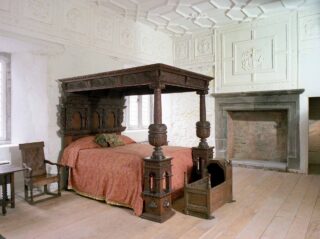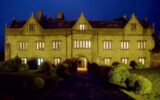Ormond Castle, Carrick-on-Suir, situated at a strategic position on the River Suir, commands access to the town of Clonmel to the north and the busy port of Waterford to the south. The Castle we see today was mainly built between the 14th and mid-16th centuries. The site also encompasses the best example of an Elizabethan manor house in Ireland which was built by Thomas, the 10th Earl of Ormond in the 1560s. Closely integrated into the manor house are two 15th century towers. It is the country's only major unfortified dwelling from that turbulent period.
Ormond Castle has the finest early examples of historically important, decorative plasterwork in Ireland. The interior of the manor contains some very fine examples, dating from between 1565 and 1575, a unique survival in Ireland.

Its decline appears to have started towards the end of the seventeenth century, when the Butlers left the house and moved north to Kilkenny. Since the Castle came into State care, various phases of work have staved off the worst potential damage to its structure. But, in recent times, problems with dampness due to water ingress have become greater and in 2014, were found to have significantly degraded the mechanical and electrical installations in the Castle, as well as compromising the remaining historic decorative plasterwork.
It is for this reason, that in 2014, the Office of Public Works made the decision to carry out major works on the structure. These works included the complete up-grade of the mechanical and electrical installations. Other works carried out include: the complete upgrade of fire and security systems, the installation of underfloor heating, the consolidation and conservation of historic internal plasterwork, scaffold and minor roof repairs, lightning protection, the upgrading of existing storm water services and sewerage system, and the refurbishment of visitor and guide facilities.
One of the more ambitious aspects of the works was the decision to restore the historic appearance of the castle by rendering the exterior of the building using a traditional lime render, accurately matching the castle’s original exterior render. This facilitates the breathability and flexibility required for such a structure while at the same time affording protection against the weather. All modern internal plaster and pointing both externally and internally that contained cement was removed and replaced with traditional lime-based materials.

In the past most of our much-loved stone buildings, including Ormond Castle, were rendered. We know this because the stones used to build the walls of Ormond are of poor quality and were not intended to be seen, or expected to be the final protection against the weather. This is further supported by the presence of “dressed” stone elements – especially around windows and other architectural features, that are of a quality and finish intended to be shown. Surviving plaster can be seen today on the earlier towers as well as on the Manor House. Samples of this plaster were taken, tested and replicated and the current project was carried out using a render mix not unlike the mix which was used originally.
In tandem with the building project, the OPW’s Heritage Services, with the support of Fáilte Ireland, commissioned a new interpretative exhibition for the site, to tell its story to visitors over the years in a new and exciting way. This positions Ormond Castle as a key offering within Ireland’s Ancient East and will open the way for new developments at the site. The hope of Fáilte Ireland and the OPW’s Heritage Services is that the newly presented and restored Castle will prove an irresistible draw to visitors to the South East and will ensure that many more tourists come to the area and stay longer, enjoying its many attractions.

About the Author
Flora O’Mahony is the architect in charge of the works at Ormond Castle. She is an RIAI registered architect, specialised in conservation.
Following completion of a BArch degree in 1996, at the School of Architecture, University College Dublin, Flora obtained a Masters in the Conservation of Historic Towns & Buildings at the prestigious R. Lemaire International Centre for Conservation at the K.U.Leuven, Belgium.
After working with the Council of Europe in Bruges, Belgium, Flora worked with Dublin based conservation architect, Paul Arnold. Flora then joined the National Inventory of Architectural Heritage (“NIAH”) and advised Local Authorities in relation to the inclusion of particular structures in their Record of Protected Structures.
Since 2006, Flora has been working as a Conservation Architect with the National Monuments Service, Office of Public Works and is responsible for the management, maintenance and conservation of 123 National Monuments in the southeast of the Ireland, including such sites as Jerpoint Abbey, Nenagh Castle, Tintern Abbey and Ormond Castle.


